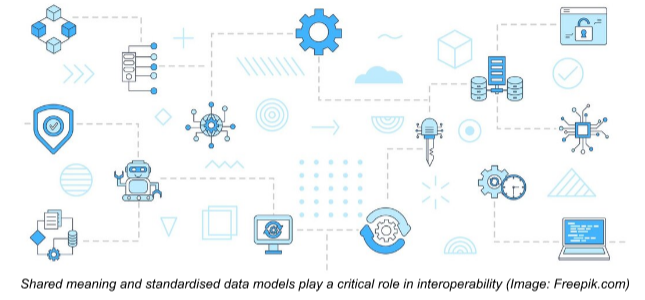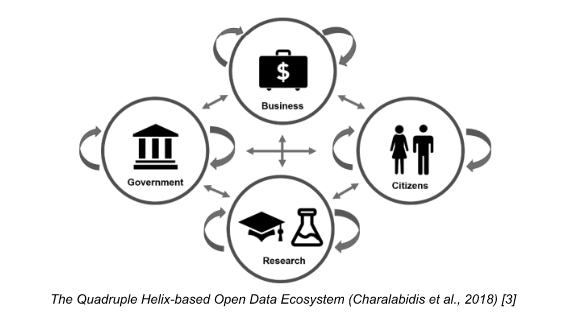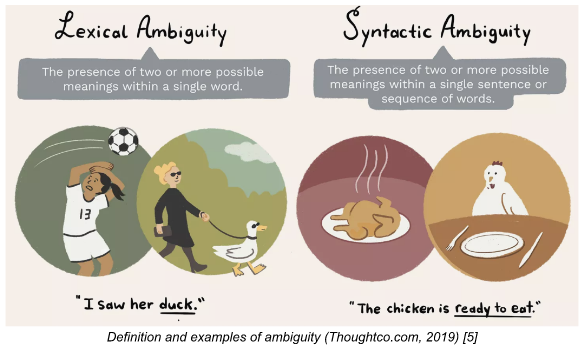“Developing clear standards to ensure systems communicate with each other in a common language they all understand.”
– Office of the National Coordinator for Health Information Technology –
“Semantic interoperability ensures that the precise format and meaning of exchanged data and information is preserved and understood throughout exchanges between parties, in other words, what is sent is what is understood”. (European Commission, 2023) [1]. It is also a key component of the data quality: When making data publicly available, several desired (or absolutely necessary on many occasions) properties need to be taken into consideration and catered for. Data quality is a multidimensional concept including, among others, data privacy, completeness, timeliness, but also technical aspects, such as
interoperability, with semantic interoperability being one of the focused areas of practice. These requirements, in their presence or absence, affect the data positively or negatively, rendering it beneficial and promotive for societal development or completely useless.
“Open data becomes usable when a human can understand it and a machine can manipulate it.”
– data.europa.eu –
Advancements in technologies like Artificial Intelligence (AI) and Internet of Things (IoT), have enabled a smoother shift from conventional to inter-communicative systems and have introduced various improvements related to interoperability. Semantic (from Ancient Greek: “significant”, “meaningful”) interoperability, deals with the meaning of things, objects, notions, or concepts in the world and how this cognitive ability of otherwise human nature, can be inherited to machines in a manner which facilitates making sense out of data and enables its manipulation and handling.
What is machine-understandable information?
When semantic links among data exist to indicate their relationships, their meaning and their context, the data is more likely to be automatedly understandable by machines, making communication between disparate systems seamless. Shared meaning, structured data and following formally established standards per domain, help systems to adopt a commonly understood language to communicate with each other by default.

Why is interoperability important?
Interoperability of all levels becomes especially important when the plethora of data produced every day concerns all sectors of society (Healthcare, Education, Culture, Governance, Finance, Law and more) and it has immediate effect on citizens’ lives, but also on the government, industry and academia. The information systems of all the aforementioned sectors need to be in the position to share and transmit information with unambiguous meaning within their domain, but also in relation to the other domains.

What happens without interoperability?
Imagine a doctor editing a patient’s record in the information system A. Under the field “diagnosis” he/she enters “lateral epicondylitis”. The same patient visits a hospital in a different country for check-up and the doctor there enters in system B the information “tennis elbow”. How will systems A and B manage to understand that “lateral epicondylitis” and “tennis elbow” refer to the same thing?
This is only a simplified example, however, this communication gap, in different contexts, can understandably have severe and multiparametric consequences patient-wise, system-wise, and more. This semantic disconnection among similar concepts can also result in poor search experience through vast data sources, where the linkability of data becomes a necessity.

Purpose of improving interoperability for open data
The non-standardised approaches for information representation to allow for a more automated processing of data, the heterogeneous data sources, the disparate information systems, and the lack of context-rich information to accompany the data, are only some of the challenges that are encountered on the road to achieving highly interoperable systems and data. Plenty of academic research has already been conducted, and various, domain specific solutions have been proposed, however, what becomes more and more apparent is that there is no fit-to-all solution for interoperability and a number of extra parameters
need to be taken into consideration when talking about open data and aiming towards a sustainable open data ecosystem. The research role of semantic interoperability in the ODECO project is to examine the existing challenges in Open and Linked Data ecosystems and to enable the web of data (Semantic Web /Web 3.0) by tackling the lack of semantic relationships to link data and enrich the metadata models under a sectoral but also domain-specific approach.
Acknowledgements
The author acknowledges the financial support from the European Union’s Horizon 2020 research and innovation program under the Marie Skłodowska-Curie grant agreement No 955569.
References
1) New European Interoperability Framework – European Commission. (n.d.). Retrieved January 26, 2023, from https://ec.europa.eu/isa2/sites/isa/files/eif_brochure_final.pdf
2) The Official Portal for European Data. (n.d.). Retrieved January 26, 2023, from https://data.europa.eu/elearning/en/module5/#/id/co-01
3) Charalabidis, Y., Zuiderwijk, A., Alexopoulos, C., Janssen, M., Lampoltshammer, T.,Ferro, E. (2018). Open Data Interoperability. In: The World of Open Data. Public
Administration and Information Technology, vol 28. Springer, Cham. https://doi.org/10.1007/978-3-319-90850-2_5
4) McGlothlin, S. (2022, October 18). Semantic interoperability in healthcare, Simplified J2 Interactive. J2 Interactive. Retrieved January 26, 2023, from https://www.j2interactive.com/blog/semantic-interoperability-healthcare
5) Nordquist, R. (2019, June 24). Definition and examples of ambiguity. ThoughtCo. Retrieved January 26, 2023, from https://www.thoughtco.com/ambiguity-language-1692388
Author:
Maria Ioanna Maratsi
University of the Aegean, Greece



